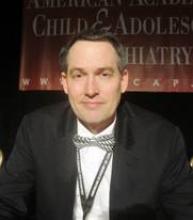WASHINGTON – The DSM-5’s inclusion of separate criteria for posttraumatic stress disorder in preschool children probably will lead to more young children getting the diagnosis, which will be a positive development because PTSD is under-recognized in this population, Dr. Michael S. Scheeringa contended.
The preschool criteria are child friendly. Intrusive recollections, for instance, don’t have to be distressing, as in the adult criteria, because sometimes such recollections do not seem to bother very young kids. "They’ll bring up their intrusive recollections to the cashier at the supermarket and seem eager to talk about them, rather than distressed," he said.
Similarly, detachment and estrangement criteria have been "reworded to say ‘socially withdrawn,’ because children can’t verbalize that they feel detached, but it can be observed that they are socially withdrawn," said Dr. Scheeringa, a pediatric PTSD researcher who also serves as an associate professor of psychiatry and neurology at Tulane University in New Orleans.
Perhaps the biggest change is that preschool children – those below the age of 7 years – will need to show just one avoidance and numbing symptom instead of the three required by the DSM-IV. Three is "too high for young children because they can’t show or express a lot of those internalized avoidance and numbing symptoms. It’s just developmentally impossible, like the sense of a foreshortened future – a child’s sense of future when they are 3 or 4 is tomorrow," he said at a psychopharmacology update sponsored by the American Academy of Child and Adolescent Psychiatry.
The increase in the number of young children likely to get the PTSD diagnosis under the new criteria is significant, because the illness historically has been underdiagnosed and missed in children, said Dr. Scheeringa, whose research contributed to the changes.
The DSM-IV requirement for irritability and anger outbursts also has been tweaked for preschoolers to include extreme temper tantrums, and the requirement for diminished interest in significant activities has been broadened to include restrictions in play and social interactions. "Young children don’t have jobs; they don’t have school; they don’t have hobbies. What they do is play and interact with other people; that’s where their interests would be diminished," he said.
"A skeptic might say, ‘Aren’t you just diagnosing mildly symptomatic kids? Aren’t you just lowering the bar?’ " but that doesn’t seem to be the case – the DSM-IV was simply missing small children with PTSD, he said.
In one of Dr. Scheeringa’s studies, DSM-IV criteria diagnosed PTSD in 13% of 284 trauma-exposed children aged 3-6 years; the DSM-5 criteria did so in about half, and those children had at least six symptoms (J. Trauma Stress 2012;25:359-67).
"Usually in treatment studies, they require five symptoms, so [these children] were really symptomatic. We’re not just diagnosing mildly symptomatic kids with" the new approach, Dr. Scheeringa said.
In general, psychotherapy – trauma-focused cognitive-behavioral therapy (CBT) in particular – is the first-line treatment for PTSD in both children and adults. "I would consider [psychiatric drugs] a distant second," he said. If needed, prazosin is likely to help with nightmares, benzodiazepines can take the edge off situational anxiety, and sleeping pills can calm fitful sleep. SSRIs might help with overall anxiety, he said.
Comorbid depression and other problems get better as PTSD resolves, "so I would suggest, based on the evidence, to focus on the PTSD first and then see what’s left over," Dr. Scheeringa said.
Attention-deficit/hyperactivity disorder (ADHD) is the exception; patients will do better in CBT if their ADHD is under control, he said.
Dr. Scheeringa said that he had no financial disclosures.


